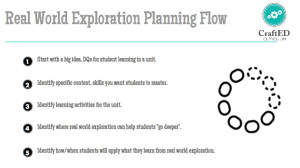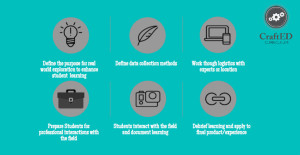Sometimes getting started is the hardest part, especially when it comes to designing deeper learning experiences that address standards AND include real world work. CraftED Curriculum would like to offer up a framework that you may find helpful when planning-we hope you find our tips and resources useful for developing your craft!
Tip 1: Zoom out, then in
Try not to mire in the muck of the details when you are first starting out planning real world experiences for students. Revert back to the classic ideas of Wiggins and McTighe and start with the end in mind. Reflect upon the following:
- What do you want students to really walk away with?
- Why should they care?
- How will this push them deeper in their learning?
From there gradually map out standards/learning targets, and what meaningful teaching and learning will look like.
Tip 2: Structure real world work to ensure rigor
We want to be sure that when students are out in the field that this time is leveraged as an opportunity for students to go deeper in their learning. In order to do that we must think through what data students will collect, how they will analyze it and ultimately apply it to a great purpose and product.
Here are some things you want to be sure to prepare:
Want to learn more about crafting engaging and rigorous real world work for students? Visit www.craftedcurricu.staging.wpengine.com to see our teaching materials or attend one of our events to experience our real world workshop for teachers.

